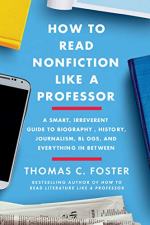
|
| Name: _________________________ | Period: ___________________ |
This quiz consists of 5 multiple choice and 5 short answer questions through Section 2: Chapter 5, "It May Just Be Me, But..." through Chapter 8, "Bringing the News".
Multiple Choice Questions
1. In Chapter 3, "The Power of the Prologue," Foster uses the word "etymologically" to describe what?
(a) The origins of words.
(b) The opposites of words.
(c) The definitions of words.
(d) Similar sounding words.
2. In Chapter 7, "All in How You Look at Things," what does Foster cite as one of the main reasons that Americans have historically trusted the news media?
(a) Journalists' willingness to admit bias.
(b) The tendency of editors to insist on multiple sources.
(c) Journalists' willingness to admit mistakes.
(d) The strict editorial control of content.
3. In Chapter 2, "The Ecology of the Nonfiction Biosphere," Foster calls an expression a "bromide." What is he saying about this expression?
(a) It is clever and concise.
(b) It is boring and mean-spirited.
(c) It is insightful but wordy.
(d) It is unoriginal and unimportant.
4. In Chapter 7, "All in How You Look at Things," what does Foster say the term "Fake News" originally referred to?
(a) News that powerful politicians dislike.
(b) Online sources of maliciously false news.
(c) Tabloid content.
(d) News the reader dislikes.
5. In Chapter 8, "Bringing the News," one of the main points that Foster wants to make about All the President's Men is what?
(a) Woodward and Bernstein used too many anonymous sources.
(b) Woodward and Bernstein faced serious obstacles in investigating the Watergate story.
(c) It is unusual for people to write about themselves in the third person.
(d) All the President's Men is a work of nonfiction.
Short Answer Questions
1. In Chapter 7, "All in How You Look at Things," Foster tells us that changing the structure of a story changes its what?
2. In Chapter 2, "The Ecology of the Nonfiction Biosphere," what implicit assertion about online writing does Foster make?
3. In Chapter 7, "All in How You Look at Things," what does Foster say beginning writers often get too caught up in?
4. In Chapter 1, "The Structure of Nonfiction Information," Foster introduces the term "structural design," saying that it is similar to which term related to fiction?
5. In Chapter 6, "Source Code," Foster talks about the change in value over time of a reporter's eyewitness testimony. What does Foster call this change in value?
|
This section contains 416 words (approx. 2 pages at 300 words per page) |

|




